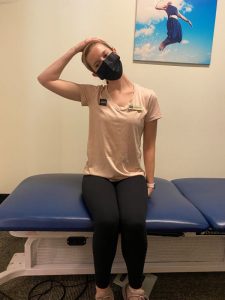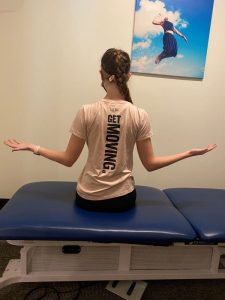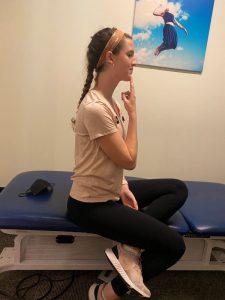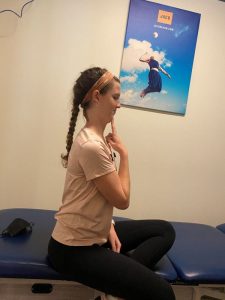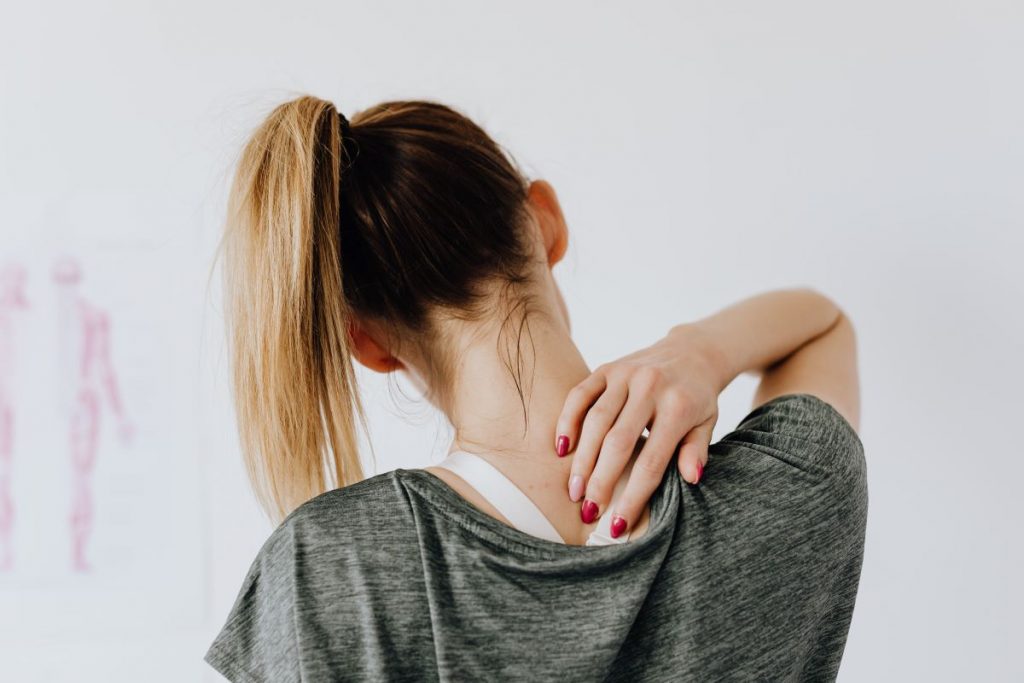
Your neck and upper back pain could be a result of bad posture. Pain from bad posture is common with prolonged sitting and often has a direct correlation with work-from-home jobs. (2)
For example, back when offices shut down during COVID-19, most people were not prepared or equipped to have a proper desk set-up. Our clinic saw a rise in patients with upper back and neck pain, most of which were related to working long hours hunched in a less-than-ideal workspace.
Whether you’re still working from home or back to the office, consider working on your postural control to prevent dysfunction and discomfort from your nine to five. Read on to figure out how. If you have questions, reach out to us!
What Is Bad Posture?
Posture refers to body position. When your body is held in a position for a prolonged period of time, we tend to call that poor posture. Poor posture becomes postural dysfunction if it becomes uncomfortable or painful. And if that pain is specific to your neck, it’s called “cervical” postural dysfunction.
Your neck houses the “cervical” portion of your spine, which is the top part of your spinal column. The cervical spine is responsible for stability and mobility to the head and neck.
Our bodies are meant to move often. Staying in one position for long periods of time will cause some muscles to tighten and others to lengthen, resulting in an imbalance that will eventually lead to discomfort and pain.
Prolonged deviation of your head away from your center of gravity (such as a forward head position) will also increase the load on the upper cervical joints. This can be responsible for headaches, pinched nerves, and dizziness—all conditions we see often in the clinic. (1)
Causes of Poor Posture and Forward Head Position
Many factors can contribute to poor posture, but here are some common ones:
- Posture at work: Sitting with head leaning forward or backward for long durations, sitting slouched in your chair at work or while on the computer.
- Your pillow: You want your neck to be in a neutral position as you sleep to reduce strain on the neck.
- Underdeveloped back muscles: If the muscles between your shoulder blades are weak, they may not have the endurance to hold you in a good position against gravity’s pull throughout your day.
Sitting in a posture for too long during your day, like at your desk at work, can result in muscular changes, like:
- Tightened pecs (muscles in the front of the chest)
- Weakened deep neck flexors (muscles in the front of your neck)
- Tight suboccipitals (tightness in the back of your neck)
- Weak periscapular muscles (weakness in muscles between and around your shoulder blades)
Poor posture can result in issues later, like:
- Headaches
- Muscle spasms and tenderness
- Reduced range of motion and pain with movement
- Osteoarthritis of the neck joints
- Cervical radiculopathy (nerve symptoms into the arm and hand)
- Temporomandibular jaw problems (also known as TMJ which causes pain with mouth movement)
- Shoulder impingement (painful pinching at the shoulder)
Posture Corrector: Are Braces Bad for You?
Postural corrective braces that claim to correct posture and reduce chronic neck pain can actually be detrimental to your recovery when not used properly.
Bracing throughout your day can be harmful when used without performing postural corrective exercises. Relying on a posture corrective brace long-term can lead to further atrophy, or muscle weakening, of the postural muscles responsible for keeping our body in an optimal position. This can be true for many types of braces unless specifically prescribed by your doctor or a physical therapist.
These braces are only a temporary fix. Just as exercise can increase muscle mass and improve strength, not using these postural muscles can lead to weakness and a loss in muscle mass. And when the brace is removed, the muscles are less capable of performing their job than they already were.
Before you consider a postural corrector, ask your physical therapist to see if you need one and how to properly use it.
What Causes Postural Problems?
Postural problems tend to result from stress, strain, and our day-to-day activities and habits.
Examples include:
- Weak muscles
- Tight muscles
- High-stress jobs or desk jobs
- Heavy labor jobs
- Carrying a heavy backpack or purse
Does Posture Get Worse with Age?
There are several factors that can alter our posture as we age. One of the structures affected by age is our spinal column, which is made up of several components:
- Vertebrae: Bones that stack on top of each other to make up your spine.
- Intervertebral discs: Cartilage cushions situated between your vertebrae.
- Muscles: Many strong, active structures that support the spine.
All of these components can change as we age. If we don’t keep these components strong and healthy, it can lead to a “stooping” posture.
- Our vertebrae can develop osteopenia or osteoporosis as we age. These terms refer to the loss of bone density, which makes them slightly smaller in size.
- The intervertebral discs lose their flexibility and harden, compressing the length of the spine.
- The muscles that surround the spine lose strength, known as sarcopenia, which leaves the body susceptible to gravity’s pull as we stoop further forward.
Other factors such as vertebral bone fractures and arthritis of the spine can lead to the vertebrae and discs becoming more rigid, painful, and curved.
Getting older comes with a lot of changes to the body such as the bones, muscles, and joints—even for the healthiest individuals. But there are things we can do to age well and maintain postural health.
How Can You Improve Posture?
The approach is fairly simple: Strengthen the muscles that are weak, and stretch the muscles that are tight.
Don’t hesitate to see a physical therapist for postural issues. We can help to identify “problem areas” and how to target them effectively.
Come by and see us at JACO Rehab to get a comprehensive, individualized plan to help reduce your pain and improve your posture.
How Can Physical Therapy Help?
Physical therapy can help prevent postural dysfunction from becoming a chronic, or long-term, recurring issue.
What to Expect
During your first session, the physical therapist will identify factors that may be contributing to your neck pain. They will assess your motion, mobility, muscle tightness, and strength to come up with your exercise plan.
Each person is different—one size does not fit all when it comes to treatment. Physical therapists are experts at explaining and prescribing proper treatment protocols. They will also give you a home exercise program to start making improvements and building healthy habits.
Check out our blog on the importance of getting a good home exercise program.
Having poor posture can impact our appearance, confidence, and well-being. Thankfully, there are exercises that can help correct most postural problems and reduce pain levels throughout the day.
Exercises to Get You Started
Targeted exercises can help combat your symptoms and prevent further progression of postural dysfunction. Here are some examples of exercises to get you started:
Upper Trap Stretch
Place your hand on top of your head and gently pull your head down into a side-bending position (ear towards shoulder) for 30 seconds. Perform the stretch twice on each side.
Shoulder Blade Squeezes
Squeeze your shoulder blades down and back, and hold for 10 seconds. You should feel the muscles between your shoulder blades activating and the front of your chest opening up.
Chin Tucks
Place your hands on your chin and retract your neck backward with a slight nod at the chin. Do not bring your chin down to your chest, instead try to make a double chin by pressing your head back. Hold for 5 seconds and perform 5 times.
Written by Katie Leen Mansfield, DPT
Resources
1. Chu, E. C., Lo, F. S., & Bhaumik, A. (2020). Plausible impact of forward head posture on upper cervical spine stability. Journal of family medicine and primary care, 9(5), 2517. https://www.ncbi.nlm.nih.gov/pmc/articles/PMC7380784/
2. Shaikh, A., Devi, O., & Patil, A. (2021). To Study the Impact of Work from Home on Back and Neck Pain among Employees during Covid-19 Pandemic. Journal of Research in Business and Management, 9(2), 29-32. https://www.academia.edu/download/65783188/F09022932.pdf
